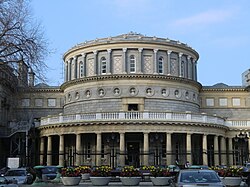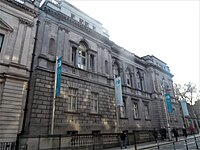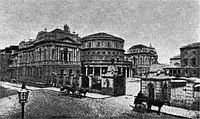National Library of Ireland: Difference between revisions
Created page with "{{Infobox building |name=National Library of Ireland |irish=Leabharlann Náisiúnta na hÉireann |county=Dublin |picture=National Library of Ireland 2011.JPG |picture caption=..." |
No edit summary |
||
| Line 13: | Line 13: | ||
|architect=Thomas Newenham Deane | |architect=Thomas Newenham Deane | ||
|type=Library | |type=Library | ||
|website= | |website=https://www.nli.ie/ | ||
}} | }} | ||
The '''National Library of Ireland''' is the [[Republic of Ireland]]'s national library. It stands on Kildare Street in [[Dublin]], in a building designed by Thomas Newenham Deane. The Minister for Culture, Heritage and the Gaeltacht is the member of the Irish Government responsible for the library. | The '''National Library of Ireland''' is the [[Republic of Ireland]]'s national library. It stands on Kildare Street in [[Dublin]], in a building designed by Thomas Newenham Deane. The Minister for Culture, Heritage and the Gaeltacht is the member of the Irish Government responsible for the library. | ||
| Line 31: | Line 31: | ||
An agreement of 1881 provided that the Library should operate under the superintendence of a Council of twelve Trustees, eight of whom were appointed by the Society and four by the Government; this Agreement also conferred on the Trustees the duty of appointing the officers of the Library. This arrangement remained in place until the library became an autonomous cultural institution in 2005. | An agreement of 1881 provided that the Library should operate under the superintendence of a Council of twelve Trustees, eight of whom were appointed by the Society and four by the Government; this Agreement also conferred on the Trustees the duty of appointing the officers of the Library. This arrangement remained in place until the library became an autonomous cultural institution in 2005. | ||
After the foundation of the Irish Free State in 1924/5 the Library was transferred to the Department of Education under which it remained until 1986 when it was transferred to the Department of the Taoiseach. In 1927 the Library was granted legal deposit status under the Industrial and Commercial Property (Protection) Act 1927. In 1992 the Library transferred to the newly established Department of Arts, Culture and the Gaeltacht (now Culture, Heritage and the Gaeltacht)<ref>{{cite web|url=http://www.irishstatutebook.ie/eli/1993/si/21/made/en/print|date=20 January 1993| | After the foundation of the Irish Free State in 1924/5 the Library was transferred to the Department of Education under which it remained until 1986 when it was transferred to the Department of the Taoiseach. In 1927 the Library was granted legal deposit status under the Industrial and Commercial Property (Protection) Act 1927. In 1992 the Library transferred to the newly established Department of Arts, Culture and the Gaeltacht (now Culture, Heritage and the Gaeltacht)<ref>{{cite web|url=http://www.irishstatutebook.ie/eli/1993/si/21/made/en/print|date=20 January 1993|accessdate=13 August 2018|title=S.I. No. 21/1993 - Arts and Culture (Transfer of Departmental Administration and Ministerial Functions) Order, 1993|author=Taoiseach Albert Reynolds|website=Irish Statute Book}}</ref> and on 3 May 2005 became an autonomous cultural institution under the National Cultural Institutions Act 1997. | ||
==Collections== | ==Collections== | ||
The National Library of Ireland houses collections of archival papers, including personal notes and work books, of the following eminent writers: | The National Library of Ireland houses collections of archival papers, including personal notes and work books, of the following eminent writers: | ||
* Roddy Doyle<ref name=hean/> | * Roddy Doyle<ref name=hean/> | ||
* Seamus Heaney<ref name=hean>{{cite news|url=http://www.independent.ie/entertainment/arts/seamus-heaney-declutters-home-and-donates-personal-notes-to-national-library-2970392.html|title=Seamus Heaney declutters home and donates personal notes to National Library|date=21 December 2011| | * Seamus Heaney<ref name=hean>{{cite news|url=http://www.independent.ie/entertainment/arts/seamus-heaney-declutters-home-and-donates-personal-notes-to-national-library-2970392.html|title=Seamus Heaney declutters home and donates personal notes to National Library|date=21 December 2011|accessdate=21 December 2011|first=Lyndsey|last=Telford|work=Irish Independent|publisher=Independent News & Media}}</ref> | ||
* Michael D. Higgins<ref name=hean/> | * Michael D. Higgins<ref name=hean/> | ||
* James Joyce<ref name=hean/> | * James Joyce<ref name=hean/> | ||
Latest revision as of 17:29, 19 January 2021
| National Library of Ireland Irish: Leabharlann Náisiúnta na hÉireann | |
|
County Dublin | |
|---|---|
 The front façade of the National Library | |
| Type: | Library |
| Location | |
| Grid reference: | O16303371 |
| Location: | 53°20’28"N, 6°15’16"W |
| City: | Dublin |
| History | |
| Address: | Kildare Street |
| Built 1877 | |
| By: | Thomas Newenham Deane |
| Library | |
| Information | |
| Website: | https://www.nli.ie/ |
The National Library of Ireland is the Republic of Ireland's national library. It stands on Kildare Street in Dublin, in a building designed by Thomas Newenham Deane. The Minister for Culture, Heritage and the Gaeltacht is the member of the Irish Government responsible for the library.
The mission of the National Library of Ireland is 'To collect, preserve, promote and make accessible the documentary and intellectual record of the life of Ireland and to contribute to the provision of access to the larger universe of recorded knowledge'
The library is a reference library and, as such, does not lend. It has a large quantity of Irish and Irish-related material which can be consulted without charge; this includes books, maps, manuscripts, music, newspapers, periodicals and photographs. Included in their collections is material issued by private as well as government publishers.
The Chief Herald of Ireland and National Photographic Archive are attached to the library. The library holds exhibitions and holds an archive of Irish newspapers. It is also the ISSN National Centre for Ireland. The library also provides a number of other services including genealogy.
The main library building is on Kildare Street, adjacent to Leinster House and the archaeology section of the National Museum of Ireland.
History

The National Library of Ireland was established by the Dublin Science and Art Museum Act 1877, which provided that the bulk of the collections in the possession of the Royal Dublin Society, should be vested in the then Department of Science and Art for the benefit of the public and of the Society, and for the purposes of the Act.
An agreement of 1881 provided that the Library should operate under the superintendence of a Council of twelve Trustees, eight of whom were appointed by the Society and four by the Government; this Agreement also conferred on the Trustees the duty of appointing the officers of the Library. This arrangement remained in place until the library became an autonomous cultural institution in 2005.
After the foundation of the Irish Free State in 1924/5 the Library was transferred to the Department of Education under which it remained until 1986 when it was transferred to the Department of the Taoiseach. In 1927 the Library was granted legal deposit status under the Industrial and Commercial Property (Protection) Act 1927. In 1992 the Library transferred to the newly established Department of Arts, Culture and the Gaeltacht (now Culture, Heritage and the Gaeltacht)[1] and on 3 May 2005 became an autonomous cultural institution under the National Cultural Institutions Act 1997.
Collections
The National Library of Ireland houses collections of archival papers, including personal notes and work books, of the following eminent writers:

See also
Outside links
| ("Wikimedia Commons" has material about National Library of Ireland) |
- National Library of Ireland
- National Library of Ireland Catalogue, including digitised material
- Sources: A National Library of Ireland database for Irish research
- National Library of Ireland on Flickr
- National Library of Ireland's online exhibitions:
References
- ↑ Taoiseach Albert Reynolds (20 January 1993). "S.I. No. 21/1993 - Arts and Culture (Transfer of Departmental Administration and Ministerial Functions) Order, 1993". http://www.irishstatutebook.ie/eli/1993/si/21/made/en/print. Retrieved 13 August 2018.
- ↑ 2.0 2.1 2.2 2.3 2.4 2.5 Telford, Lyndsey (21 December 2011). "Seamus Heaney declutters home and donates personal notes to National Library". Irish Independent (Independent News & Media). http://www.independent.ie/entertainment/arts/seamus-heaney-declutters-home-and-donates-personal-notes-to-national-library-2970392.html. Retrieved 21 December 2011.
